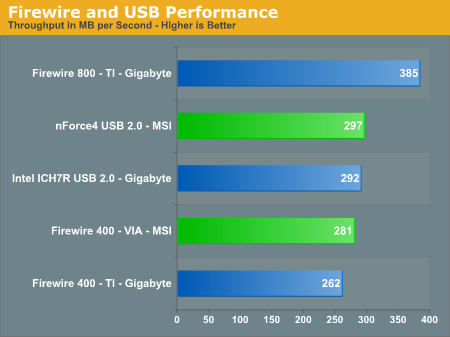Intel Motherboards: Can a Diamond beat a Royal Flush?
by Gary Key on September 23, 2005 12:05 AM EST- Posted in
- Motherboards
Firewire and USB Performance
After looking at many options for Firewire and USB testing, we finally determined that an external USB 2.0, Firewire 400, and Firewire 800 hard disk might be a sensible way to look at USB and Firewire throughput.
Our first efforts at testing with an IDE or SATA drive as the "server" yielded very inconsistent results, since Windows XP sets up cache schemes to improve performance. Finally, we decided to try a RAM disk as our "server", since memory removed almost all overhead from the serving end. We also managed to turn off disk caching on the USB and Firewire side by setting up the drives for "quick disconnect" and our results were consistent over many test runs.
We used 2GB of fast 3-2-2-4 system memory set up as a 450MB RAM disk and 1550MB of system memory. Our standard file is the SPECviewPerf install file, which is 432,533,504 bytes (412.4961MB). After copying this file to our RAM disk, we measured the time for writing from the RAM disk to our external USB 2.0 or Firewire 400 or Firewire 800 drive using a Windows timing program written for AnandTech by our own Jason Clark. The copy times in seconds were then converted into Megabits per second (Mb) to provide a convenient means of comparing throughput. Higher Rates, therefore, mean better performance.
Our test is just one of many throughput tests, but in this benchmark, it is clear that the VIA Firewire 400 chip is faster than TI's 1394a chip. The NVIDIA nForce4 USB 2.0 controller is slightly faster than Intel's solution.
After looking at many options for Firewire and USB testing, we finally determined that an external USB 2.0, Firewire 400, and Firewire 800 hard disk might be a sensible way to look at USB and Firewire throughput.
Our first efforts at testing with an IDE or SATA drive as the "server" yielded very inconsistent results, since Windows XP sets up cache schemes to improve performance. Finally, we decided to try a RAM disk as our "server", since memory removed almost all overhead from the serving end. We also managed to turn off disk caching on the USB and Firewire side by setting up the drives for "quick disconnect" and our results were consistent over many test runs.
We used 2GB of fast 3-2-2-4 system memory set up as a 450MB RAM disk and 1550MB of system memory. Our standard file is the SPECviewPerf install file, which is 432,533,504 bytes (412.4961MB). After copying this file to our RAM disk, we measured the time for writing from the RAM disk to our external USB 2.0 or Firewire 400 or Firewire 800 drive using a Windows timing program written for AnandTech by our own Jason Clark. The copy times in seconds were then converted into Megabits per second (Mb) to provide a convenient means of comparing throughput. Higher Rates, therefore, mean better performance.

Our test is just one of many throughput tests, but in this benchmark, it is clear that the VIA Firewire 400 chip is faster than TI's 1394a chip. The NVIDIA nForce4 USB 2.0 controller is slightly faster than Intel's solution.










19 Comments
View All Comments
smn198 - Friday, September 23, 2005 - link
Welcome Gary. Look forward to seeing more from you.Gary Key - Friday, September 23, 2005 - link
smn198,Thank you. I really enjoyed doing this article, working with Wes, and having the opportunity to share my experiences with the great members and visitors here at AnandTech. I certainly hope you will be seeing more from me. ;-)
Sincerely,
Gary Key
Evan Lieb - Friday, September 23, 2005 - link
Welcome Gary, and have fun!Ecmaster76 - Friday, September 23, 2005 - link
Looks like it went up early.Good read though. At first I was like "Holy $#!+" when I saw the gaming benchmarks, but then they mentioned about the Gigabyte BIOS being effed up.
cryptonomicon - Thursday, September 22, 2005 - link
DRAM Voltage Auto, 1.80V to 2.3V in 0.1V incrementsuh.. but isnt ram like 2.5-2.8v?
Pete84 - Friday, September 23, 2005 - link
DDR2 runs at much lower vdimm than DDR.cryptonomicon - Friday, September 23, 2005 - link
ah yes of course..so much for active cooling then
BlvdKing - Thursday, September 22, 2005 - link
I can't believe the Nforce 4 for AMD supports dual core but the Intel edition only has limited support and no support for the 820.coomar - Wednesday, September 21, 2005 - link
no a diamond can't beat a royal flush